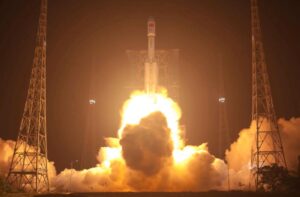The delivery was announced by the China Manned Space Engineering Office Monday and is part of intense preparations for construction of a modular space station in low Earth orbit.
China is currently readying a Long March 5B rocket to launch Tianhe, aroughly 22-metric-ton spacecraft which will serve as the core space station module. That mission is expected to launch in late April.
The recently delivered Long March 7 kerosene-liquid oxygen propellant medium-lift rocket will be assembled to launch the Tianzhou-2 cargo and supply spacecraft to dock with the core module.
The Tianzhou-2 mission will provide Tianhe with propellant for maintaining its orbital altitude as well as supplies for hosting astronauts. The cargo spacecraft will have a mass of around 13,000 at liftoff, with a cargo mass of around 6,500 kilograms.
The Shenzhou-12 mission, launching on a Long March 2F rocket from Jiuquan, will subsequently send three astronauts for the Tianhe core module.
Chinese space authorities have not revealed a detailed timeline for the upcoming missions. However previous launch campaigns for the Long March 5B and Long March 7 rockets indicate the Tianhe launch is likely to take place near the end of April, with the Tianzhou-2 mission ready to go by mid-May. Shenzhou-12 could launch as soon as June.
The Long March 5B to launch the core module will be rolled out to the launch pad around a week ahead of launch. The Long March 7 will roll out to a different pad at Wenchang around 5 days before its later launch.
China is aiming to construct its three-module space station with 11 launches across 2021-2022. These will consist of three module launches and visits by four crewed missions and four cargo spacecraft. Chinese astronauts are currently in training for space station missions, with 12 astronauts expected to fly on the four missions.
A Long March 2F rocket is also to be on standby at Jiuquan to perform emergency rescue missions to the space station, a senior space official stated in March.
The three-module, 66-metric-ton space station will host three astronauts for six month rotations. Planned experiments include international projects in the areas of astronomy, space medicine, space life science, biotechnology, microgravity fluid physics, microgravity combustion and space technologies.
The outpost will orbit at between 340-450 kilometers for at least 10 years. Orbital inclination will be around 43 degrees to allow crewed launches to the station from Jiuquan in the Gobi Desert. The station could potentially be expanded to six modules, using apparent backup modules.
The components for the 53-metre-long Long March 7 were delivered to Qinglan port, Hainan island, by cargo vessel Xu Yang 16 following collection from the northern port city of Tianjin.
The Long March 7 was first launched in 2016, carrying a scale version of a return capsule for a new-generation crew spacecraft. The second mission a year later sent Tianzhou-1 to dock with the Tiangong-2 space lab. That mission tested and verified technologies for fuel transfer in microgravity, a necessary capability for maintaining a low Earth orbit space station.
The Long March 5B was designed to launch space station modules to LEO. It had a successful test flight in May 2020 carrying a prototype Chinese new-generation spacecraft for crewed missions.
China had aimed to begin construction of the space station in 2018 or 2019, but the failure of the second Long March 5 rocket in July 2017 resulted in delays. The country is now condensing the space station construction phase while maintaining a 2022 goal for its completion.
The space station plan was conceived in 1992 and has seen China become only the third country to develop independent human spaceflight capabilities.
China has launched six crewed missions. The first, Shenzhou-5, launched in 2003, with the latest, Shenzhou-11, carried out in 2016.



